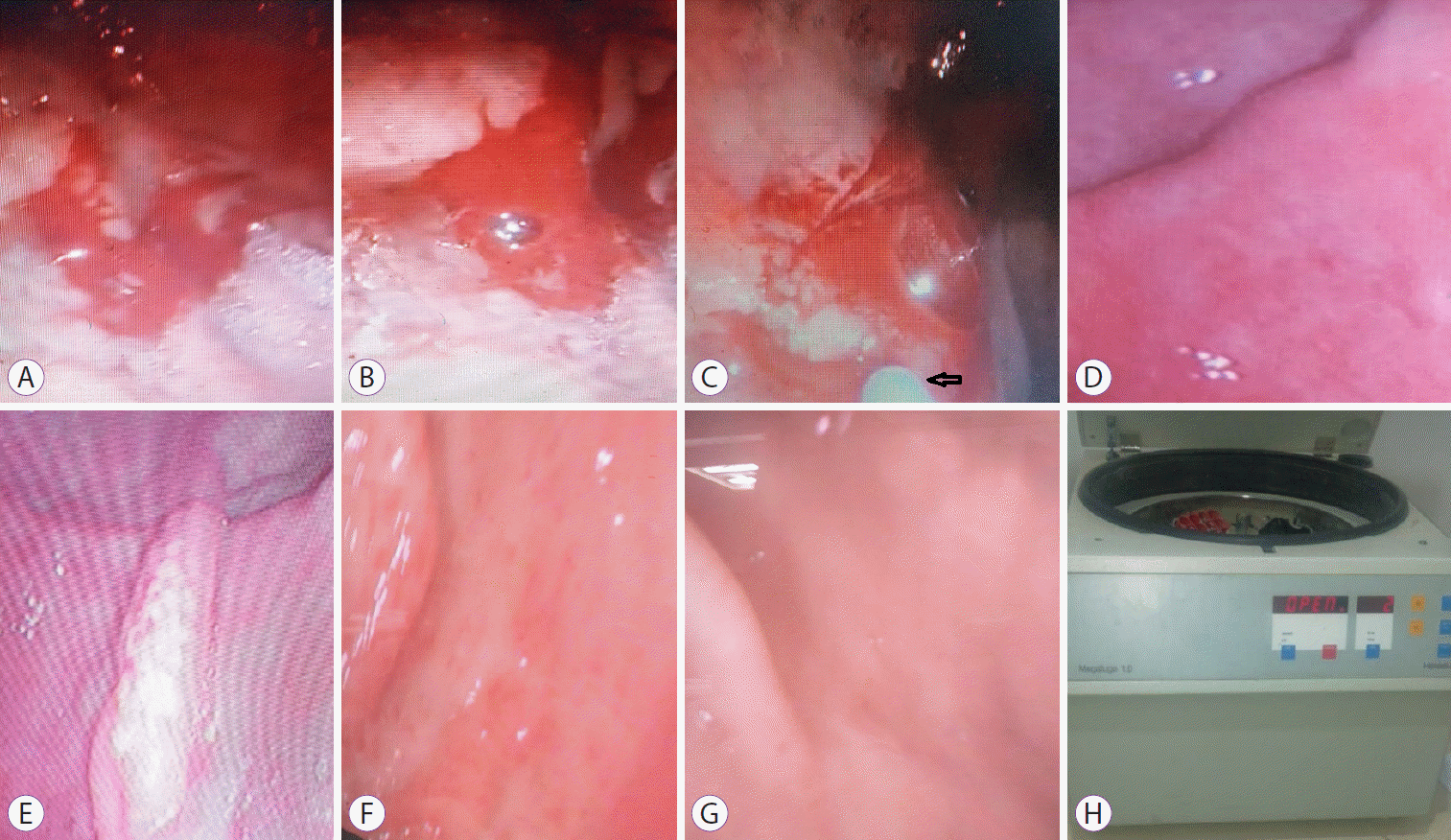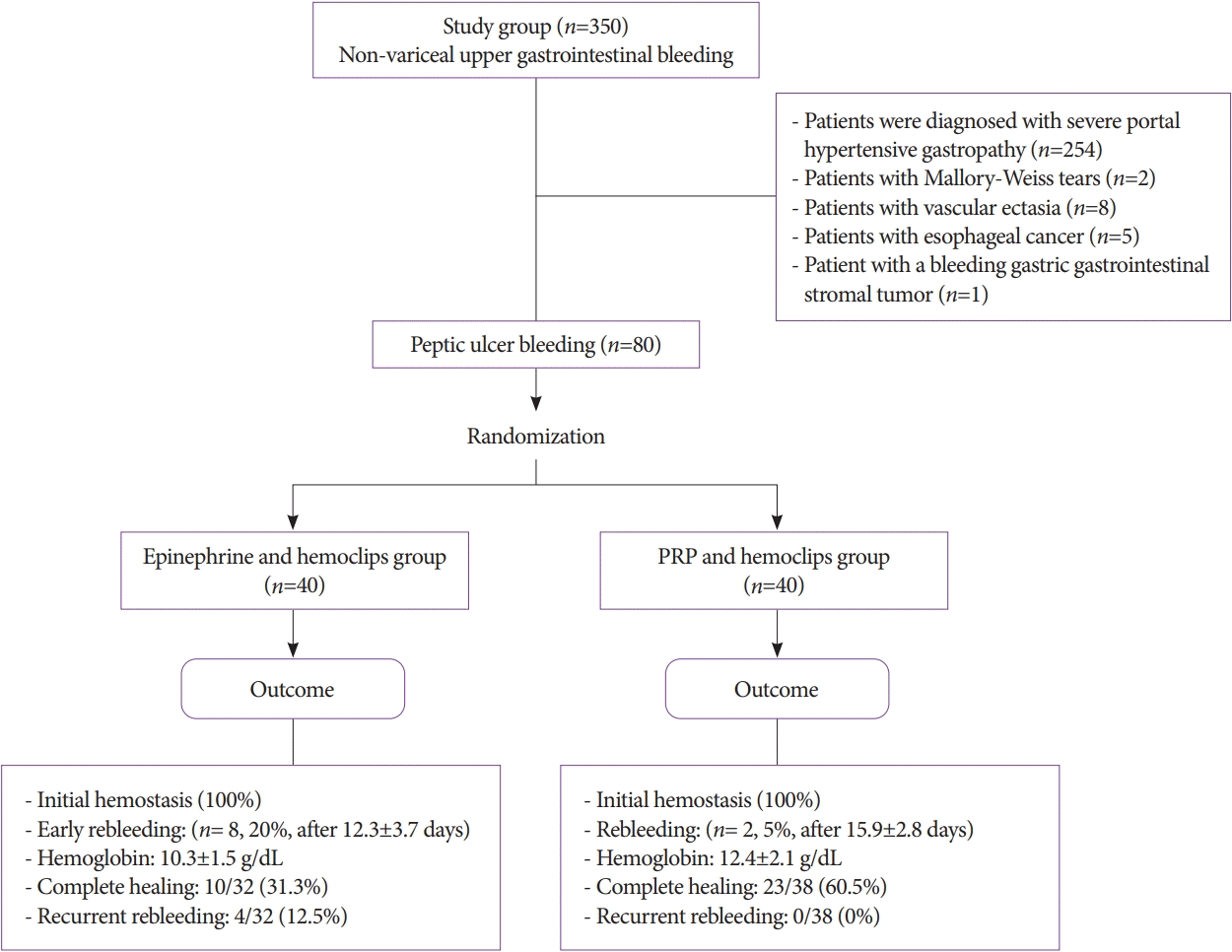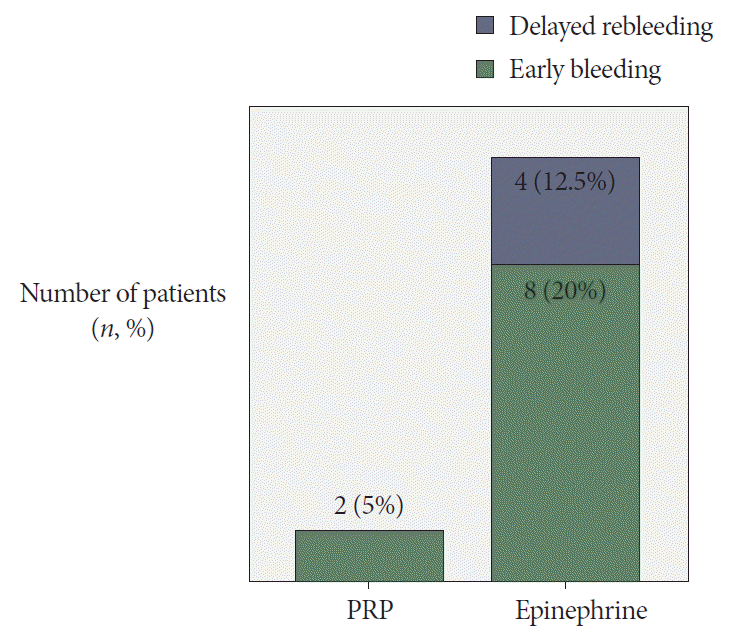1. Jacques J, Legros R, Chaussade S, Sautereau D. Endoscopic haemostasis: an overview of procedures and clinical scenarios. Dig Liver Dis. 2014; 46:766–776.

2. Everts PA, Knape JT, Weibrich G, et al. Platelet-rich plasma and platelet gel: a review. J Extra Corpor Technol. 2006; 38:174–187.
3. Marx RE. Platelet-rich plasma: evidence to support its use. J Oral Maxillofac Surg. 2004; 62:489–496.

4. Valeri CR, Saleem B, Ragno G. Release of platelet-derived growth factors and proliferation of fibroblasts in the releasates from platelets stored in the liquid state at 22 degrees C after stimulation with agonists. Transfusion. 2006; 46:225–229.
5. Sunitha Raja V, Munirathnam Naidu E. Platelet-rich fibrin: evolution of a second-generation platelet concentrate. Indian J Dent Res. 2008; 19:42–46.

6. Antoniades HN, Williams LT. Human platelet-derived growth factor: structure and function. Fed Proc. 1983; 42:2630–2634.
7. Lindeboom JA, Mathura KR, Aartman IH, Kroon FH, Milstein DM, Ince C. Influence of the application of platelet-enriched plasma in oral mucosal wound healing. Clin Oral Implants Res. 2007; 18:133–139.

8. Ramos-Torrecillas J, De Luna-Bertos E, García-Martínez O, Díaz-Rodríguez L, Ruiz C. Use of platelet-rich plasma to treat pressure ulcers: a case study. J Wound Ostomy Continence Nurs. 2013; 40:198–202.
9. Wrotniak M, Bielecki T, Gaździk TS. Current opinion about using the platelet-rich gel in orthopaedics and trauma surgery. Ortop Traumatol Rehabil. 2007; 9:227–238.
10. Yol S, Tekin A, Yilmaz H, et al. Effects of platelet rich plasma on colonic anastomosis. J Surg Res. 2008; 146:190–194.

11. Pallua N, Wolter T, Markowicz M. Platelet-rich plasma in burns. Burns. 2010; 36:4–8.

12. Barkun AN, Bardou M, Kuipers EJ, et al. International consensus recommendations on the management of patients with nonvariceal upper gastrointestinal bleeding. Ann Intern Med. 2010; 152:101–113.

13. Forrest JA, Finlayson ND, Shearman DJ. Endoscopy in gastrointestinal bleeding. Lancet. 1974; 2:394–397.

14. Konstantinidis A, Valatas V, Ntelis V, et al. Endoscopic treatment for high-risk bleeding peptic ulcers: a comparison of epinephrine alone with epinephrine plus ethanolamine. Ann Gastroenterol. 2011; 24:101–107.
15. Kovacs TO. Management of upper gastrointestinal bleeding. Curr Gastroenterol Rep. 2008; 10:535–542.

16. Aabakken L. Current endoscopic and pharmacological therapy of peptic ulcer bleeding. Best Pract Res Clin Gastroenterol. 2008; 22:243–259.

17. Chau CH, Siu WT, Law BK, et al. Randomized controlled trial comparing epinephrine injection plus heat probe coagulation versus epinephrine injection plus argon plasma coagulation for bleeding peptic ulcers. Gastrointest Endosc. 2003; 57:455–461.

18. van Leerdam ME. Epidemiology of acute upper gastrointestinal bleeding. Best Pract Res Clin Gastroenterol. 2008; 22:209–224.

19. Hearnshaw SA, Logan RF, Lowe D, Travis SP, Murphy MF, Palmer KR. Acute upper gastrointestinal bleeding in the UK: patient characteristics, diagnoses and outcomes in the 2007 UK audit. Gut. 2011; 60:1327–1335.

20. Laine L, Jensen DM. Management of patients with ulcer bleeding. Am J Gastroenterol. 2012; 107:345–360. quiz 361.

21. Szura M, Pasternak A. Upper non-variceal gastrointestinal bleeding - review the effectiveness of endoscopic hemostasis methods. World J Gastrointest Endosc. 2015; 7:1088–1095.

22. Gralnek IM, Dumonceau JM, Kuipers EJ, et al. Diagnosis and management of nonvariceal upper gastrointestinal hemorrhage: European Society of Gastrointestinal Endoscopy (ESGE) guideline. Endoscopy. 2015; 47:a1–a46.

23. Schmidt A, Gölder S, Goetz M, et al. Over-the-scope clips are more effective than standard endoscopic therapy for patients with recurrent bleeding of peptic ulcers. Gastroenterology. 2018; 155:674–686.e6.

24. Barkun A. Hemostatic powder TC-325. Gastroenterol Hepatol (NY). 2015; 11:489–491.
25. Prei JC, Barmeyer C, Bürgel N, et al. EndoClot polysaccharide hemostatic system in nonvariceal gastrointestinal bleeding: results of a prospective multicenter observational pilot study. J Clin Gastroenterol. 2016; 50:e95–e100.
26. Kurt M, Onal I, Akdogan M, et al. Ankaferd blood stopper for controlling gastrointestinal bleeding due to distinct benign lesions refractory to conventional antihemorrhagic measures. Can J Gastroenterol. 2010; 24:380–384.

27. Smith PA. Intra-articular autologous conditioned plasma injections provide safe and efficacious treatment for knee osteoarthritis: an FDA-sanctioned, randomized, double-blind, placebo-controlled clinical trial. Am J Sports Med. 2016; 44:884–891.
28. de la Portilla F, Segura-Sampedro JJ, Reyes-Díaz ML, et al. Treatment of transsphincteric fistula-in-ano with growth factors from autologous platelets: results of a phase II clinical trial. Int J Colorectal Dis. 2017; 32:1545–1550.

29. Long DW, Johnson NR, Jeffries EM, Hara H, Wang Y. Controlled delivery of platelet-derived proteins enhances porcine wound healing. J Control Release. 2017; 253:73–81.

30. Dijkstra-Tiekstra MJ, van der Schoot CE, Pietersz RN, Reesink HW. White blood cell fragments in platelet concentrates prepared by the platelet-rich plasma or buffy-coat methods. Vox Sang. 2005; 88:275–277.

31. Adler SC, Kent KJ. Enhancing wound healing with growth factors. Facial Plast Surg Clin North Am. 2002; 10:129–146.

32. Jeong E, Yoo IK, Cakir OO, et al. Effectiveness of autologous platelet-rich plasma for the healing of ulcers after endoscopic submucosal dissection. Clin Endosc. 2019; 52:472–478.

33. Jensen DM, Eklund S, Persson T, et al. Reassessment of rebleeding risk of Forrest IB (Oozing) peptic ulcer bleeding in a large international randomized trial. Am J Gastroenterol. 2017; 112:441–446.






 PDF
PDF Citation
Citation Print
Print





 XML Download
XML Download